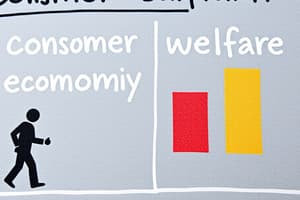Podcast
Questions and Answers
What is a potential, often overlooked, reason why people in poverty might choose home births over institutional deliveries?
What is a potential, often overlooked, reason why people in poverty might choose home births over institutional deliveries?
Poor quality of care in institutional settings, leading to a rational decision to avoid them.
The text mentions the author's regret. What specific action does the author wish they had taken, and what is the broader lesson?
The text mentions the author's regret. What specific action does the author wish they had taken, and what is the broader lesson?
The author regrets not fighting hard enough for the idea that improving the quality of institutional care is essential. The broader lesson is to advocate strongly for beliefs, especially when they challenge prevailing assumptions.
Kazakhstan plans to remove fuel subsidies and replace them with cash transfers. What broad economic problem are they likely trying to solve?
Kazakhstan plans to remove fuel subsidies and replace them with cash transfers. What broad economic problem are they likely trying to solve?
Fuel subsidies are inefficient, costly, and often disproportionately benefit wealthier individuals. Cash transfers can be more targeted and efficient in supporting vulnerable populations.
Why might economists prefer cash transfers to in-kind subsidies, such as fuel subsidies, even if the cost to the government is the same?
Why might economists prefer cash transfers to in-kind subsidies, such as fuel subsidies, even if the cost to the government is the same?
What are some challenges in implementing a cash transfer program to replace fuel subsidies effectively?
What are some challenges in implementing a cash transfer program to replace fuel subsidies effectively?
Explain how market demand is derived for a single good (x) when considering two individuals (Person 1 and Person 2).
Explain how market demand is derived for a single good (x) when considering two individuals (Person 1 and Person 2).
Outline the steps required to determine the competitive equilibrium price (px) in a two-person economy with goods x and y.
Outline the steps required to determine the competitive equilibrium price (px) in a two-person economy with goods x and y.
What is Walras' Law, and how does it relate to the equilibrium in multiple markets?
What is Walras' Law, and how does it relate to the equilibrium in multiple markets?
Describe the conditions necessary for the First Welfare Theorem to hold true.
Describe the conditions necessary for the First Welfare Theorem to hold true.
Explain how a competitive equilibrium achieves a Pareto Optimal allocation.
Explain how a competitive equilibrium achieves a Pareto Optimal allocation.
What does it mean for markets to be 'efficient' according to the First Welfare Theorem?
What does it mean for markets to be 'efficient' according to the First Welfare Theorem?
Why might a Pareto Optimal allocation achieved through competitive equilibrium still be considered undesirable from a societal perspective?
Why might a Pareto Optimal allocation achieved through competitive equilibrium still be considered undesirable from a societal perspective?
Summarize how the competitive equilibrium framework can be used to analyze public finance issues.
Summarize how the competitive equilibrium framework can be used to analyze public finance issues.
In the context of Pareto optimality, if individual L possesses all of good X, why must L also possess all of good Y for the situation to be considered Pareto optimal?
In the context of Pareto optimality, if individual L possesses all of good X, why must L also possess all of good Y for the situation to be considered Pareto optimal?
Briefly explain how viewing economics as the study of 'What gets produced,' 'Who produces it,' and 'How is the production distributed' helps in understanding Pareto optimality.
Briefly explain how viewing economics as the study of 'What gets produced,' 'Who produces it,' and 'How is the production distributed' helps in understanding Pareto optimality.
Why is it that a 'reasonable' distribution should be Pareto Optimal?
Why is it that a 'reasonable' distribution should be Pareto Optimal?
How do markets, through price mechanisms, shift individuals from potentially non-Pareto Optimal 'endowments' to the contract curve?
How do markets, through price mechanisms, shift individuals from potentially non-Pareto Optimal 'endowments' to the contract curve?
Describe what is meant by an 'endowment' in the context of market equilibrium, using an example.
Describe what is meant by an 'endowment' in the context of market equilibrium, using an example.
Explain the significance of the contract curve in relation to Pareto optimality and market equilibrium.
Explain the significance of the contract curve in relation to Pareto optimality and market equilibrium.
Given the Cobb-Douglas utility functions (U_L = x_L^\alpha y_L^{1-\alpha}) and (U_M = x_M^\alpha y_M^{1-\alpha}), what do (x), (y), and (\alpha) represent?
Given the Cobb-Douglas utility functions (U_L = x_L^\alpha y_L^{1-\alpha}) and (U_M = x_M^\alpha y_M^{1-\alpha}), what do (x), (y), and (\alpha) represent?
How do prices, $p_x$ and $p_y$, and endowments, $w_x$ and $w_y$, influence the movement towards the contract curve?
How do prices, $p_x$ and $p_y$, and endowments, $w_x$ and $w_y$, influence the movement towards the contract curve?
What is the core principle behind the Rawlsian approach to resource allocation?
What is the core principle behind the Rawlsian approach to resource allocation?
Explain the meaning of the term 'Maxmin function' in the context of utility allocation.
Explain the meaning of the term 'Maxmin function' in the context of utility allocation.
How does the Rawlsian allocation differ from other potential utility allocations?
How does the Rawlsian allocation differ from other potential utility allocations?
In the graph provided, what geometric method is suggested to find the Rawlsian allocation?
In the graph provided, what geometric method is suggested to find the Rawlsian allocation?
What initial agreement between Lucas and Uma leads them to prefer a Rawlsian approach?
What initial agreement between Lucas and Uma leads them to prefer a Rawlsian approach?
Why might a society choose a Rawlsian allocation over a utilitarian one?
Why might a society choose a Rawlsian allocation over a utilitarian one?
Explain how the Rawlsian approach addresses potential inequalities in initial endowments or circumstances.
Explain how the Rawlsian approach addresses potential inequalities in initial endowments or circumstances.
What are the potential drawbacks of strictly adhering to a Rawlsian allocation?
What are the potential drawbacks of strictly adhering to a Rawlsian allocation?
How could you mathematically represent the Rawlsian objective function for allocating utility between two individuals, Lucas and Uma?
How could you mathematically represent the Rawlsian objective function for allocating utility between two individuals, Lucas and Uma?
Consider a scenario where Lucas's initial utility is very high and Uma's is very low. How would the Rawlsian approach adjust this allocation?
Consider a scenario where Lucas's initial utility is very high and Uma's is very low. How would the Rawlsian approach adjust this allocation?
In this economic model, why is it sufficient to determine the price ratio rather than the specific prices of both goods?
In this economic model, why is it sufficient to determine the price ratio rather than the specific prices of both goods?
Explain how the incomes of individuals L and M (IL and IM) are determined in the model.
Explain how the incomes of individuals L and M (IL and IM) are determined in the model.
Given the Cobb-Douglas demand functions, explain how the demand for good x by individual L ($x_L^*$) is derived?
Given the Cobb-Douglas demand functions, explain how the demand for good x by individual L ($x_L^*$) is derived?
In the context of market clearing, explain why the total demand for good x ($x_L + x_M$) must equal the total endowment of good x ($W_x$)?
In the context of market clearing, explain why the total demand for good x ($x_L + x_M$) must equal the total endowment of good x ($W_x$)?
In the context of an exchange economy, explain how the concept of a 'market' ensures that voluntary exchange leads individuals to the contract curve.
In the context of an exchange economy, explain how the concept of a 'market' ensures that voluntary exchange leads individuals to the contract curve.
Using the utility functions provided for individuals L and M, briefly explain the condition under which all allocations are Pareto optimal.
Using the utility functions provided for individuals L and M, briefly explain the condition under which all allocations are Pareto optimal.
What is the significance of deriving the equation for $p_x$ in terms of $W_x$, $W_y$, and $\alpha$?
What is the significance of deriving the equation for $p_x$ in terms of $W_x$, $W_y$, and $\alpha$?
Explain why, if individual L possesses all of good X ((W_x)), they must also possess all of good Y ((W_y)) for the allocation to be Pareto optimal.
Explain why, if individual L possesses all of good X ((W_x)), they must also possess all of good Y ((W_y)) for the allocation to be Pareto optimal.
Describe the relationship between the Marginal Rate of Substitution of L (MRSL) and the price ratio ($p_x/p_y$) when L is maximizing utility.
Describe the relationship between the Marginal Rate of Substitution of L (MRSL) and the price ratio ($p_x/p_y$) when L is maximizing utility.
Given the utility functions (U_L = x_L^\alpha y_L^{1-\alpha}) and (U_M = x_M^\alpha y_M^{1-\alpha}), and endowments (w_L^x, w_L^y) and (w_M^x, w_M^y) for L and M respectively, describe how prices (p_x) and (p_y) play a role in reaching the contract curve.
Given the utility functions (U_L = x_L^\alpha y_L^{1-\alpha}) and (U_M = x_M^\alpha y_M^{1-\alpha}), and endowments (w_L^x, w_L^y) and (w_M^x, w_M^y) for L and M respectively, describe how prices (p_x) and (p_y) play a role in reaching the contract curve.
Explain how deriving the contract curve demonstrates that the prices obtained in the market lead to Pareto efficient allocations.
Explain how deriving the contract curve demonstrates that the prices obtained in the market lead to Pareto efficient allocations.
In the context of exchange between individuals L and M, both with Cobb-Douglas utility functions, what would be the effect on the contract curve if both individuals had identical preferences?
In the context of exchange between individuals L and M, both with Cobb-Douglas utility functions, what would be the effect on the contract curve if both individuals had identical preferences?
Explain why setting $p_y = 1$ is called setting y as the numeraire.
Explain why setting $p_y = 1$ is called setting y as the numeraire.
Explain how an initial endowment of goods X and Y for individuals L and M influences the eventual location of exchange on the contract curve.
Explain how an initial endowment of goods X and Y for individuals L and M influences the eventual location of exchange on the contract curve.
Outline the steps required to derive the contract curve in an Edgeworth Box diagram, given the utility functions for two individuals and their initial endowments of two goods.
Outline the steps required to derive the contract curve in an Edgeworth Box diagram, given the utility functions for two individuals and their initial endowments of two goods.
Describe a situation that violates the conditions necessary for individuals to reach the contract curve through market exchange, and explain why this violation prevents a Pareto optimal outcome.
Describe a situation that violates the conditions necessary for individuals to reach the contract curve through market exchange, and explain why this violation prevents a Pareto optimal outcome.
Flashcards
Respect for Decisions
Respect for Decisions
The idea that policy should respect the choices of individuals, especially when those choices are based on experience and knowledge.
Paternalistic Policy
Paternalistic Policy
Believing you can make better decisions for others about their lives, especially concerning important matters like childbirth.
Onus of Proof
Onus of Proof
Evidence is needed to justify a policy that overrides individual choices, especially when those choices are based on personal circumstances.
Cash Transfer Replacement
Cash Transfer Replacement
Signup and view all the flashcards
Fuel Subsidies
Fuel Subsidies
Signup and view all the flashcards
Numeraire
Numeraire
Signup and view all the flashcards
L's Income (IL)
L's Income (IL)
Signup and view all the flashcards
M's Income (IM)
M's Income (IM)
Signup and view all the flashcards
Cobb-Douglas Demands (x*, y*)
Cobb-Douglas Demands (x*, y*)
Signup and view all the flashcards
Individual Demand (xL)
Individual Demand (xL)
Signup and view all the flashcards
Individual Demand (xM)
Individual Demand (xM)
Signup and view all the flashcards
Total Market Demand
Total Market Demand
Signup and view all the flashcards
Marginal Rate of Substitution (MRS)
Marginal Rate of Substitution (MRS)
Signup and view all the flashcards
Market Demand Derivation
Market Demand Derivation
Signup and view all the flashcards
Market Equilibrium
Market Equilibrium
Signup and view all the flashcards
Walras’ Law
Walras’ Law
Signup and view all the flashcards
Competitive Equilibria
Competitive Equilibria
Signup and view all the flashcards
Selfish Consumption
Selfish Consumption
Signup and view all the flashcards
Perfect Information
Perfect Information
Signup and view all the flashcards
Market Clearing
Market Clearing
Signup and view all the flashcards
First Welfare Theorem
First Welfare Theorem
Signup and view all the flashcards
Contract Curve
Contract Curve
Signup and view all the flashcards
The 'Market'
The 'Market'
Signup and view all the flashcards
Endowments
Endowments
Signup and view all the flashcards
Contract Curve with Identical Preferences
Contract Curve with Identical Preferences
Signup and view all the flashcards
Prices
Prices
Signup and view all the flashcards
Pareto Optimal Allocations
Pareto Optimal Allocations
Signup and view all the flashcards
Rawlsian Approach
Rawlsian Approach
Signup and view all the flashcards
Maxmin Function
Maxmin Function
Signup and view all the flashcards
Rawlsian Allocations
Rawlsian Allocations
Signup and view all the flashcards
45-degree Line
45-degree Line
Signup and view all the flashcards
Rawlsian Allocation Construction
Rawlsian Allocation Construction
Signup and view all the flashcards
Utilitarian Allocations
Utilitarian Allocations
Signup and view all the flashcards
Utility
Utility
Signup and view all the flashcards
Allocation
Allocation
Signup and view all the flashcards
Pareto Optimality
Pareto Optimality
Signup and view all the flashcards
Pareto Optimal
Pareto Optimal
Signup and view all the flashcards
Pareto Optimal Allocation (Example)
Pareto Optimal Allocation (Example)
Signup and view all the flashcards
Three Facets of Economics
Three Facets of Economics
Signup and view all the flashcards
Reasonable Distribution
Reasonable Distribution
Signup and view all the flashcards
Role of Market Equilibrium
Role of Market Equilibrium
Signup and view all the flashcards
Cobb-Douglas Preferences (L & M)
Cobb-Douglas Preferences (L & M)
Signup and view all the flashcards
Study Notes
Consumer Surplus
- Consumer surplus equals the area of the triangle ABC
- An increase in consumer surplus (area BCFD), occurs in part because existing consumers now pay less (area BCED) and in part because new consumers enter the market at the lower price (area CEF).
Consumer Surplus from the Kazakh Problem
- If you only observe the two demands, you can just use a linear approximation
- It can involve calculating the following: Area of rectangle = (a+b+c), area "c" and CS=(a+b+c)-c
- In the example case, use 1/2 x (25+50) = 37.5 for the linear calculation
Consumer Surplus for the Kazakh Problem (Exact Calculation)
- Calculating the area under the Marshallian demand curve between prices 1 and 2 yields 34.65
Welfare in $ from Kazakh Problem
- Includes a table containing the data for fuel subsidies, no fuel subsidies, with cash compensations, and linear approx
Consumer Surplus from the Kazakh Problem
- The theory has no direct link with consumer surplus
- However, CV > ACS > EV is observed
- A general result for a price increase
- For price declines, CV < ACS < EV
Compensating Variation
- The $ amount required to give a person after a policy change to make them as well off as before the change
- Evaluated at the utility prior to the change
Equivalent Variation
- The $ amount a person would be willing to give up to avoid a policy change
- Evaluated at the utility after the change
Elasticity of Demand
- Consumer surplus is smaller when demand is elastic versus when demand is inelastic
- The elasticity of demand depends on available and close substitutes
Human Reaction
- Not reacting means that you are badly hurt by the reaction and need what you are buying
- Reacting to change, means it is easy to find substitutes and switch behaviors
- If there are close substitutes available, then people are not tied or married to consuming the good that was subsidized
Consumer Theory Architecture
- Consumers aim to do the best for themselves within a budget
Child Mortality
- A policy of incentivizing facility births with $20, did, in fact not improve the result
- Key is not respect for decisions of the poor.
Kazahk Fuel Subsidies
- If the government stops these subsidies, but replace them with cash transfer
- Initial price P(food) = $1, P(oil) = $1, P(oil) will increase to $2
- Income is, say, $100
- Started with U(x,y) = x^0.5 y^0.5 (Cobb-Douglas) and I=100
Pareto Optimality and Exchange Economies
- Important terms to learn: Exchange Economy, Contract Curve, Pareto Optimality, Equilibrium Prices, and Market Clearing
- A theoretical example was every Halloween Lucas and Uma go trick or treating and return with two types of candy
- Lucas: Cobb-Douglas Utility, U L = √T/√S, Uma: Cobb-Douglas Utility, UM = √T/√S
- This time they returned with 3 Twix and 3 Sour Patches
Contract Curve
- To find the function, need both consumers to be tangent to each other
- The function" is a function of YL=f(XL)
Market Equilibrium
- Also known as competitive equilibrium
- Has several properties:
- General in nature of competitive equilibria
- Markets clear
- Consumers are on the contract curve so that the allocation is Pareto Optimal
Studying That Suits You
Use AI to generate personalized quizzes and flashcards to suit your learning preferences.




